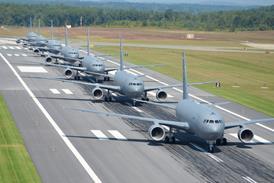COLIN BAKER / LONDON
Aircraft noise issues are once again set to dominate the next ICAO triennial General Assembly but engine emissions are rising up the agenda too
Any flies on the wall at the 33rd General Assembly of the International Civil Aviation Organisation (ICAO) in Montreal should be in for an interesting time. The assemblies, held every three years, are often preceded by months of meetings between technocrats, diplomats and representatives from the aviation industry. This time is no different.
So there will be much relief when the doors are opened in Montreal on 25 September. A lot has been accomplished since the last assembly in 1998 - not least a new Chapter 4 engine noise standard. However, the three years since they last met have been dominated by disagreement between the USA and Europe over the phase-out of the noisiest Chapter 3 engines, and a final resolution to this conflict is likely to be a bridge too far.
The European Commission (EC), under pressure from various sources including the European parliament, airports and the green lobby, wants a speedy phase-out of both the noisiest Chapter 3 engines and Chapter 2 engines that are hushkitted to meet (or often, squeeze into) Chapter 3 classification. It already plans to ban hushkitted aircraft from 2002 and is keen on a rapid phase-out of aircraft within 5dB of Chapter 3 in the near future.
The USA, again under pressure from bodies such as hushkit manufacturers and those with large hushkit fleets, has dug its heels in and has issued an Article 84 complaint procedure against Brussels, accusing the EC of breaking ICAO rules with its hushkit ban.
This has left ICAO president Dr Assad Kotaite with the delicate task of brokering a compromise. Although progress has been made, it is likely that the details will have to wait until after the assembly. And, as always, the devil is in the detail.
In the 33rd Assembly's working paper 43 (A33-WP43), ICAO has set out an assembly resolution it intends to present to all 187 members. EC and US officials met over two days in August to try and thrash out their differences. One ICAO official says that he cannot recall so much time being spent on one document. The working paper has been pored over "word for word".
A33-WP43 sets out a possible compromise which will allow airports to consider operating restrictions as part of a balanced programme of noise mitigation: namely reduction at source, land planning and management, noise abatement operational procedures and operational restrictions. The USA wants operating restrictions to be used only "as a last resort" while certain European states are seeking to avoid strict limitations. However, ICAO's Committee on Aviation Environmental Protection (CAEP) has made it clear that restrictions should not be used as a "first resort".
The key sticking point has been whether there should be a cap on the level to which airports can restrict noise. The USA is against a cap, mainly on a point of principle, as it has always argued that engine noise standards are only intended for certification purposes and should not be used for operating restrictions. A33-WP43 states that "further consideration" may be needed as to whether there should be a specified limit between Chapter 3 and Chapter 4, and whether it should be a set figure or expressed in qualitative terms (such as "the noisiest Chapter 3 aircraft").
While much of the attention has focused on this dispute between Brussels and Washington, another major stumbling block has appeared in recent months. As one ICAO insider put it: "Russia has suddenly woken up to the fact that it has rather a lot of Chapter 2 aircraft." Many of these fly into Europe.
Sympathy for Russia within ICAO is rather muted given the fact that the EC and Moscow agreed back in 1990 that aircraft such as the Ilyushin II-76, among others, should be phased out by April 2002. However, Russia may well gain support from African nations in a similar predicament and it is possible that an extension will be agreed.
While the noise issue has dominated the headlines, CAEP has also been working on the issue of aircraft emissions. Despite Washington's rejection of the Kyoto Protocol on reducing greenhouse gases and the failure of many other states to ratify it, ICAO officials stress that the process goes on. "I think the USA still sees the need for the work to be done," says one official.
CAEP has made progress in the areas of emission-related levies, emission trading and voluntary measures.
On emission trading, a fuel tax is seen as problematic due to international legal issues. A revenue-neutral method would need an acceptable way for defining efficiency and could not be used where there are no en-route charges.
An en-route charge would need revenues to be recycled in the aviation sector to be consistent with ICAO policy and would need to be applied worldwide to avoid competition issues. On emissions trading, CAEP prefers an open system allowing trading with different industries rather than within the airline sector.
All this shows that much has been achieved since the 32nd assembly, but the key issue of noise is likely to dominate proceedings in Montreal. And we haven't heard the last of it yet.
Source: Airline Business























